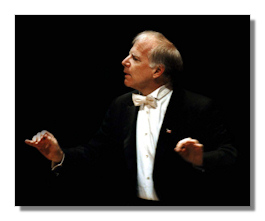
The Internet's Premier Classical Music Source
Related Links
- Latest Reviews
- More Reviews
-
By Composer
-
Collections
DVD & Blu-ray
Books
Concert Reviews
Articles/Interviews
Software
Audio
Search Amazon
Recommended Links
Site News
 Concert Review
Concert Review
Ludwig van Beethoven

The Symphonies, Program 2
- Fidelio Overture in E Major, Op. 72b (1814)
- Symphony #4 in B Flat Major, Op. 60 (1806)
- Symphony #5 in C minor, Op. 67 (1807)
Detroit Symphony Orchestra/Leonard Slatkin
Orchestra Hall, Detroit, Michigan, 9 February 2013
The Detroit Symphony Orchestra proved to be in staggering form for their second night of their first Beethoven festival in 36 years. Better weather and more familiar works ensured that the fabled 2,000 seat hall was full and abuzz with excitement. In my review of the February 8th concerts, I mentioned the excellence on display, pointing out terrific wind solos in particular. This program featured those same qualities, but with a gripping intensity that was lacking from the Third and Eighth.
Music Director Leonard Slatkin's written promise to use swift tempos and embrace modern scholarship was held up magnificently by his orchestra, who provided exciting and very clean playing all evening. While in the past – Friday's program included – the Detroit Symphony strings have taken time to find solid footing, they shot out of the opening overture with a tremendous confidence and focus. Slatkin clearly appreciates the Fidelio overture as a showpiece. While his treatment of the Leonore #3 was stunningly played but emphasized dramatic contrast, Fidelio featured sharp rhythmic attacks and a great deal of color and detail. The audience was thrilled.
As I stated previously in my review of the first installment of this series, Slakin's gifts do not show themselves in any extremes. This worked wonderfully in the Fourth, a focused and swift performance that also had a great deal of intensity. After a darkly dramatic opening, the Allegro Vivace was like sun breaking through clouds. As he had proved Friday night, Slatkin continued to be a master of dramatic shifts and Beethoven's mood changes. The first movement was followed by a lovely, flowing adagio that showed the strings and winds in very fine form. The jaunty dance of a third movement was well served by the swift approach and slightly reduced forces of the Detroit Symphony. Underneath the smiling gentleness of this oft-forgotten work, there is foreshadowing to the late symphonies, a notion Slatkin obviously agrees with. Again, tremendously clear wind solos contributed to what had been to this point as fine a performance as you could want.
Thankfully, the finale didn't disappoint. Never once allowing tempos to drag, Slatkin led his players through a tremendously satisfying final movement, where the Detroit Symphony clearly reveled in the chance to show off. Playing the early works (and Symphony #8) like they are worthy of the great canon that is the Beethoven Symphonies goes a very long way in making these admittedly smaller pieces sound important. Slashing strings, dancing winds, and spot-on playing brought a surprising amount of the hall to its feet.
I suspect however, that many patrons and first-timers alike were there to see the Fifth, and indeed the intermission was full of questions about the second half of the program living up to the first. The Detroit Symphony played the in 2011 under Louis Langrée, a very fine musician, but this performance was better still. For one, the swift tempos and sharp rhythmic attacks that made the Fourth something special carried over to the Fifth. Nothing is duller in music than this symphony's opening movement played anything less than 100%, and stellar winds and strings made it very memorable indeed. The horns of the Detroit Symphony impress me less right now, and Orchestra Hall is so sonically alluring that it seldom forgives mistakes, but here too they rang out with confidence and clarity. Clearly energized, Slatkin put the orchestra through its paces.
But one cannot forget that this iconic symphony has three other movements. Some conductors do, and the piece sages progressively as a result. Not here. Slatkin is far too good a leader to let that happen. Thus, the second movement Andante con moto shone and urged the symphony forward on its musical journey. In particular, the Detroit Symphony brass deserve a great deal of credit, their blended tones ringing through the hall. They also stood out in the third movement scherzo, their achievements outdone only by some absolutely incredible low string playing that was perhaps the highlight of the entire performance. That led effortlessly into a swift and wholly satisfying rendition of the finale. Of all the four movements, it is most in danger of sounding stop and go, but here it was majestically flowing, retaining all the tension and excitement of the previous three. Rarely, either on disc on broadcast has the conclusion sounded so easy and natural. In response to this excellence, the crowd roared its approval for several curtain calls.
I had legitimate concerns about the Detroit Symphony embarking on a Beethoven festival this year. While a successful series of webcasts have brought the group into the spotlight, the recent strike and some questionable quality of ensemble have hung over the orchestra for some time now. However, I was warmly surprised by the first installment of the series, and have no hesitation in calling this Saturday performance one of my favorite Orchestra Hall experiences. If this festival continues to rejuvenate the ensemble, the concluding concerts will be a special experience indeed. A job well done for all involved. Next!
Copyright © 2013, Brian Wigman












